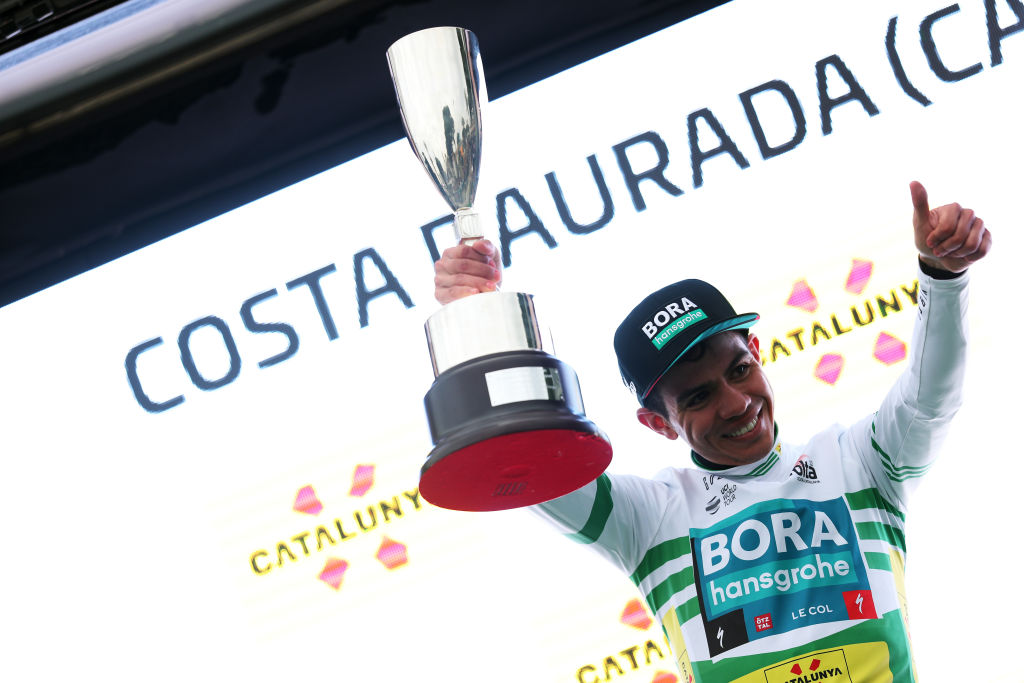Interviewed at the start line of stage 6 of the Volta a Catalunya in Salou, Sergio Higuita made a seemingly throwaway comment to media that in fact held the key to how one of cycling’s most spectacular breakaways in recent months came to succeed.
“I don’t care about the weather,” the Bora-Hansgrohe leader said as the teeming rain bounced off the microphones of reporters waiting to interview riders under leaden grey skies and with huge puddles forming on the roads along the Salou beach promenade, “I just want to race.”
Just over four hours later and five kilometres distant as the crow flies in the next coastal town of Cambrils following his epic 130-kilometre breakaway with Richard Carapaz (Ineos Grenadiers), Higuita crossed the line in second place and set to be crowned as new race leader.
He and Carapaz had taken a colossal gamble with their longest of long-range attacks. But on a rain-lashed day where there were 18 abandons and eight non-starters, including triple Volta a Catalunya winner Alejandro Valverde (Movistar), Higuita’s seeming indifference to the weather when it comes to racing paid off handsomely indeed.
“The stage started really fast, we knew the break could work out because UAE and the race leader [Joao Almeida],” Higuita said when asked to explain how and Carapaz had managed to forge a two-rider move which will surely go down as one of the most memorable break aways in the history of the Volta a Catalunya.
“Knowing that, I made sure I was in a good position, and then one of the Ineos domestiques, the Australian National Champion [Luke Plapp] laid down a really fast pace on the first big climb of the day. All of the other riders ended up easing off, and let’s say I was the last survivor of that first big battle.”
After which battle, in any case, the day’s war for the green-and-white leader’s jersey of the Volta a Catalunya began in earnest. As Higuita recounted, “We headed off and just kept going, getting a really big gap. But the key thing was to go on regulating our strength as best we could so we could be sure we’d get to the finish.”
At one point the duo’s margin stood at over three-and-a-half minutes at one point, far more than the seven seconds that previously separated Higuita from race leader Almeida, and indeed with 50 kilometres it looked as if UAE were going to give up completely until unexpected and welcome aid in the pursuit came from Norwegian squad Uno-X.
Higuita said that once the two had committed, there was little point in easing up, even if the distance and the strength of the UAE team meant managing to stay away, as they ultimately did by 48 seconds, seemed wildly improbable at times.
“We just couldn’t afford to doubt it. Even with 100 kilometres to go, we were in that break so we just went flat out. But it being such a tough stage helped make it hard to chase us down.”
Come the duel for the stage win after a strong degree of collaboration all the way to within sight of the finishing gantries, Higuita led out the sprint, but said that regardless of the usual tactics deployed in such two-way battles, after such an arduous stage weather-wise through the mountains of southern Catalonia, it came down to brute force.
“It wasn’t a question of who was faster at that point,” he reasoned, “and he was a bit stronger than me.
“Richard only got it by half a wheel, but the important thing was taking as much time as possible on the riders behind.”
Higuita and Carapaz’s move not only tore up the script of UAE’s plans for a ‘safe break’ to go clear, it also broke with a lengthy tradition in Catalunya that following its usual two mid-week Pyrenean stages, the GC battle may continue all the way to Barcelona, but an actual change of rider holding the top spot is extremely rare.
However, Higuita denied that he had been planning to go clear so early on given the rainy conditions, even if once the situation arose that allowed him to get in the break, he was more than willing to commit.
“I didn’t go on the rollers before the stage to warm up, I was just sitting on the bus feeling pretty relaxed,” he recounted. “We thought a break would go, but one with guys from a long way down on GC.
“At most we expected there to be some action at the end with crosswinds. Ineos were maybe thinking of something, but I personally wasn’t so sure. I thought a GC team was bound to test Almeida in the mountains, but finally it turned out to be Carapaz himself.” And, as it turned out, Higuita.
Numerous Volta a Catalunya races have been won with less than 16 seconds, Higuita’s current advantage over Carapaz post stage 6, but the final stage of the race, which runs each year through the Parc de Montjuïc and features repeat climbs of a tough little ascent, is also notoriously difficult to control.
Should Higuita win outright Sunday, it would not only be the first WorldTour stage race win of his youthful career. This would also be Bora-Hansgrohe’s first such overall victory at that level since Max Schachmann took Paris-Nice over a year ago.
“It’s always a very dangerous stage and Richard’s sure to be looking for something,” Higuita recognised. “Everybody’s always got an idea of fighting for the win there, so we’ll just have to try and defend it as best we can.”








